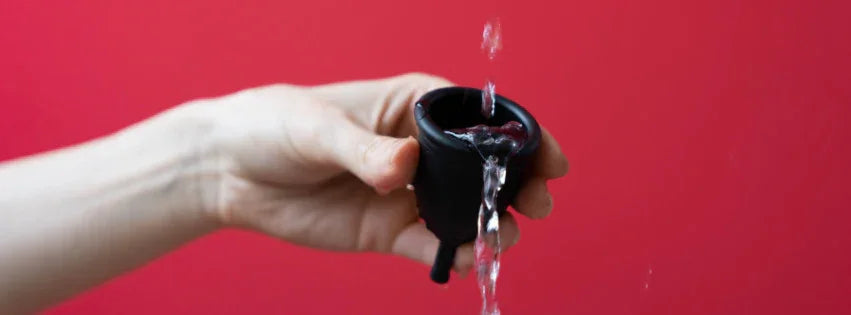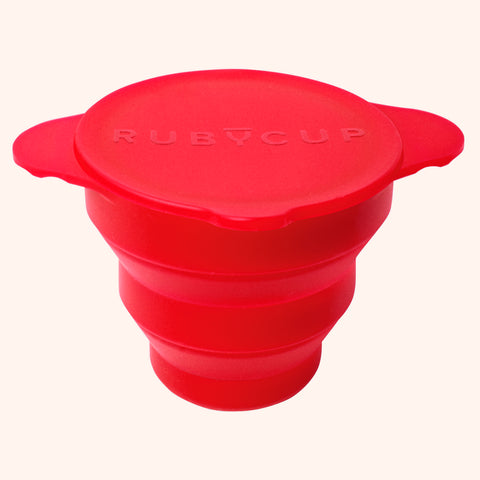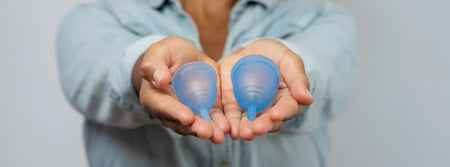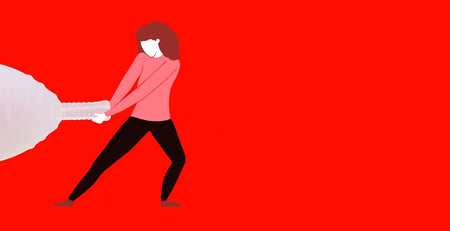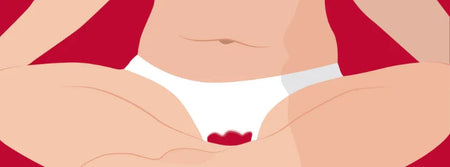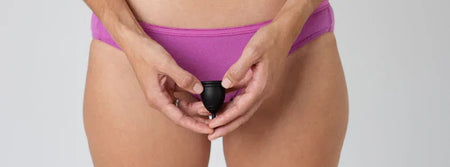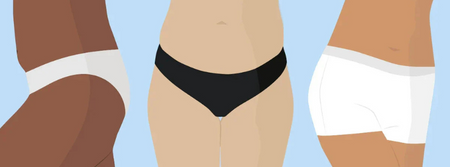You’ve probably heard that menstrual cups are an eco-friendly, easy-to-use replacement for disposable period products like pads and tampons—and you’re ready to take the plunge. But there’s one thing troubling you: how do you clean them!?
At first, the basic questions around how to use a menstrual cup can be confusing, especially when it comes to hygiene. How do you know the cup is really clean? What happens if the cup isn’t cleaned properly? But help is at hand!
We’ve put together the ultimate guide for cleaning and taking care of your menstrual cup to help you make the transition as easy as possible.
As a zero-waste menstrual cup company, we know the ins and outs of how to use the cup and make it last a long time. We want to share what we know so you can start experiencing the benefits of using a menstrual cup right away.
Keep reading to learn everything you need to know about cleaning your menstrual cup and making the switch to an earth-friendly period.
How to clean a menstrual cup: the basics
It’s super easy to clean your menstrual cup in a way that protects you from infections and keeps your cup working effectively for a long time. We get it: using a menstrual cup for the first time can be intimidating. But we hope understanding how to take care of your cup and how to clean it will help you feel more at ease.
We’ve compiled some frequently asked questions about the basics of cleaning a menstrual cup to ease your mind and help you use your cup with confidence.
How often should you clean and sterilize your menstrual cup?
First, keep in mind that there’s a difference between cleaning and sterilizing your menstrual cup.
To sterilize your menstrual cup you need to boil it for 2-3 minutes before your first use and before (or after) your period each month. You should clean your cup by rinsing and wiping it dry each time you empty it.
We’ll go into further details about both below.
What are the best ways to clean a menstrual cup?
Rinsing with water is the best way to clean a menstrual cup. Using any type of cleanser with extra ingredients could impact your pH levels, cause irritation, and potentially create more waste.
You should periodically clean the suction holes of your cup by filling it with water and squeezing it from the top down. This pushes the water through the holes and removes any debris that may have accumulated during your period. We call this the Squeeze’n’Flush method.
You can also boil your cup before using the Squeeze’n’Flush method to help loosen up anything that might be caught in the holes.
If you’re concerned that your cup may need deeper cleaning, you can scrub it with an unused toothbrush and fresh lemon juice before rinsing it and boiling it for 2-3 minutes. This method removes stains, smells, and bacteria.

Is it better to steam or boil your menstrual cup?
We only recommend that you boil your menstrual cup to sterilize it. There isn’t enough information out there to tell us for sure that steaming the cup would properly sterilize it, and we aren’t sure what effects steaming the cup may have on the integrity of the silicone. For this reason, we recommend boiling your cup between each period.
How long should you boil your menstrual cup?
Always boil your menstrual cup for 2-3 minutes. Boiling it for a shorter amount of time may allow bacteria to stay on the cup’s surface. It’s possible that repeatedly boiling it for more than 2-3 minutes may reduce the lifespan of the cup.
To help your cup last as long as possible and to prevent infections, be sure to only boil the cup for the recommended 2-3 minutes.
Is there a way to sterilize your menstrual cup without boiling it?
If you often travel or camp for long periods of time, you may be wondering if you can sterilize a menstrual cup without boiling.
The short answer is no. There’s no way to sterilize your menstrual cup without boiling it. You have to boil your cup between periods, no matter what.
If you're traveling for two months or longer and there's no way to boil your cup, you could take two menstrual cups with you (and boil both when you get home).
Keep in mind that you don’t have to sterilize your menstrual cup immediately after your period ends. Instead, you could wait to boil the cup in a pot at your next stop or use a sterilizer to boil the cup in a microwave if one becomes available during your travels. If you’re at home, it’s usually best practice to boil your menstrual cup right after your period ends and you’ve stopped using it.

How can you clean your menstrual cup in a public bathroom?
If you’re often on the go, you might wonder how to clean a menstrual cup in a public bathroom. Is it okay to rinse your cup in a public sink?
If you know you may need to empty your menstrual cup while you are out of the house, keep a reusable water bottle with you in order to rinse the cup without leaving the stall or creating more waste.
Whether or not you choose to clean your cup in a public sink is your choice. Some people feel comfortable cleaning their menstrual cups in front of other people, some don’t. Just be aware of anything you are touching as you move from inside the stall to the sink. You want your hands to be clean when you reinsert the cup. You may also want to use toilet paper to cover the cup and avoid spreading any bacteria as you leave the stall.
Can you sterilize your menstrual cup in the microwave?
Yes, you can sterilize your menstrual cup in a microwave using our Ruby Sterilizer. Just fill with water and pop into the microwave or boil in an oven for 2-3 minutes to ensure your cup is clean and ready for your next period.
How can you clean the suction holes of your menstrual cup?
- Wash your hands and leave the warm water running.
- Fill the menstrual cup with water.
- Place your hands over the wide end of the cup so that it is completely covered.
- Squeeze the cup so that the water is forced through the suction holes.

We call this the Squeeze’n’Flush method.
A few tips for cleaning the suction holes of your menstrual cup:
- If you boil your Ruby Cup before this process, the residue will get flushed out easier.
- When squeezing the cup place it as far down in the sink as possible. Water will squirt through the holes rapidly, so make sure it stays in your sink.
- Try making this move a routine. Every time you rinse your cup, Squeeze’n’Flush and you’ll keep the suction holes unblocked and working properly.
What’s the best way to store a menstrual cup?
You should store your menstrual cup somewhere dry where air can circulate. Storing your cup inside a cotton bag works great.
Menstrual cup cleaning: Products you should and should not use
There are many products out there that are marketed to clean your menstrual cup for you, but many of them are unnecessary. To make it easier to cut out the marketing noise, here’s a breakdown of what you can and can't use to clean your menstrual cup.
The gist? When in doubt, use water.
What kind of soap can you use to wash your menstrual cup?
We don’t recommend using cleansers or soaps, especially those with fragrances or oils. Cleansers can cause pH imbalances in your vagina, so we say avoid them.
Should you soak your menstrual cup in baking soda?
Never soak your menstrual cup in baking soda. Baking soda may impact the integrity of your silicone cup or irritate your vagina.
Is it a good idea to clean your menstrual cup with hydrogen peroxide?
Never clean a menstrual cup with hydrogen peroxide. It’s harsh on the cup’s material as well as harsh on your body.
What products should you avoid when washing your menstrual cup?
In general, avoid any chemical products you would use to clean your house when cleaning your menstrual cup.
Avoid:
- Scented/oil-based/antibacterial soaps
- Hydrogen peroxide
- Baking soda
- Vinegar
- Dishwashing liquid
- Rubbing alcohol
- Lubes
- Bleach
You should also avoid washing your menstrual cup in the dishwasher as it can impact the integrity of the cup. Avoiding the chemicals listed will help your cup last longer and protect your body from ph imbalance, irritation, and infection.
How to clean a menstrual cup: common issues and what to do about them
Now you know the basics, let's take a look at some of the common issues you may encounter if you’re new to the world of menstrual cups. They’re easier to solve than you'd think.
What should you do if your menstrual cup gets discolored or stained?
Discoloring and staining are completely normal and won’t impact the use or longevity of your cup.
You can scrub the menstrual cup with an unused toothbrush to help lift the stain off the silicone. Apply fresh lemon juice to help remove the stains. Rinse with cold water. Then, boil your cup for 2-3 minutes to sterilize it before your next use.
That said, if you're worried about discoloring, Ruby Cup provides the option of having your cup in black.
What should you do if your menstrual cup falls into the toilet?
If you drop your menstrual cup into a toilet, you’ll want to give it a rinse and sterilize it before using it again. However, it’s understandable that you might opt to replace the cup entirely if it falls into a public toilet.
Either way, a good practice is to keep a backup menstrual cup in your bag or car just to be safe. It’s your choice whether you continue using the cup after dropping it in a public toilet and sterilizing it.
Remember to wash your hands before and after removing the cup to avoid spreading bacteria.
What should you do if your menstrual cup smells?
It’s completely normal for your cup to carry some smells as you use it, but if your menstrual cup begins to smell sour, here’s what you can do to clean it and remove the odor.
Try not to clean the cup with hot water when you empty it. Hot water can cause the smell to sink in deeper.
Don’t leave your cup in for more than 8 hours as this can cause smells to linger.
Scrub the cup with an unused toothbrush and fresh lemon juice. Rinse with cold water.
Make sure to sterilize your menstrual cup in between each period to avoid bacteria build-up and odors.
How should you clean your menstrual cup after a yeast infection?
You should stop using your menstrual cup if you have any kind of vaginal infection and sterilize your cup before your next use. Remember that sterilizing your cup is different than cleaning it. To sterilize, boil your cup in a pot of water for 2-3 minutes or use a sterilizer (like our Ruby Sterilizer) in the microwave or oven before next use.
 How do you know if your menstrual cup is too dirty?
How do you know if your menstrual cup is too dirty?
If your cup starts to have a sour smell, it’s probably dirty and needs to be properly cleaned and sterilized.
How do you know when it’s time to replace your menstrual cup?
If the shape of the cup begins to look different or it begins to feel less bouncy, it’s probably a good idea to replace your cup to avoid leaks.
If your cup carries a sour smell that you can’t seem to get rid of with scrubbing, go ahead and replace it. A sour smell usually means bacteria and you definitely don’t want to give yourself an infection from using the cup.

What should you do with your old menstrual cup once you replace it?
The medical-grade silicone that the cups are made out of can’t be recycled with your household recyclables like cardboard or plastic. Silicone recycling is usually done at the company level rather than by individuals, so that means you will likely have to connect with a company that can recycle the cup for you.
Come As You Are, a sex toy company based in Canada, can help you recycle your menstrual cup. They have a recycling program and process silicone recyclables in-house, and they’ve confirmed that menstrual cups can be recycled through their program. To learn how to recycle your menstrual cup with Come As You Are, take a look here.
It’s also possible to burn the cup and dispose of any residue or bury the cup. These recycling methods aren’t harmful to the earth and keep the cup from going into a landfill.
Is a menstrual cup (and the cleaning regime) right for you and your flow?
If you’re still on the fence about whether to transition to a menstrual cup, you should consider your lifestyle and whether the cup makes sense for your day-to-day routine. You’ll also want to make sure the cup makes sense for your routines surrounding your period each month.
Cleaning and sterilizing your cup only takes a few minutes each month, so transitioning to a waste-free period is easier than you’d think. Remember, cleaning the cup usually only involves rinsing it with cold water, and sterilizing the cup only takes about 2-3 minutes.
Before you begin using a menstrual cup, consider when you’ll clean it based on your lifestyle and routine. Do you travel often? You will want to sterilize your cup before you leave home or bring a sterilizer with you on your trip.
Do you have irregular periods? Using a reusable period product like a menstrual cup will eliminate the need to make sure you have pads or tampons on hand even when you’re not sure your period is coming. You may also need to clean your cup more often if you menstruate more often. These questions are worth considering before you use a menstrual cup, although they certainly shouldn’t deter you from using the cup.
Related post: How to Use a Menstrual Cup: The Ultimate Beginner's Guide
With our tips, cleaning your menstrual cup will be a breeze
Following the advice above, you can now see that cleaning your menstrual cup is no hassle. Most of the time, you simply need to rinse it with water or, if it’s exposed to dirt or you’re between periods, sterilize it for 2-3 minutes in boiling water.
Keeping your menstrual cup clean can help it last longer and makes sure you avoid infections. Follow these steps and you’ll be experiencing happier, freer periods in no time—all while helping to protect the environment.
What if there was a way to help the planet while feeling happier and freer during your period? There is a way with Ruby Cup! We’ll even donate one to a person without access to safe period products when you buy from us. Grab your Ruby Cup here.
Written By Valentina Carrara
Valentina has been part of the Ruby Cup team for many years and is our go-to expert on menstrual cups. With plenty of knowledge and experience, she’s passionate about helping people understand how menstrual cups work (Ruby Cup is her favourite period product after all!) and why they’re a great option. If you have any questions or doubts, she’s always happy to help: Just drop her a message at hello@rubycup.com.


